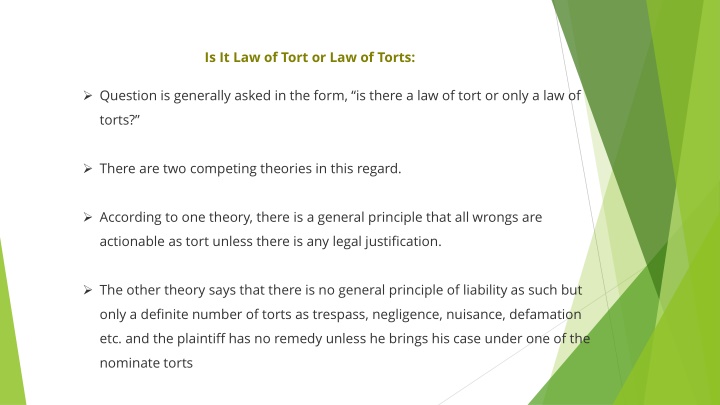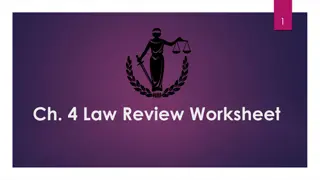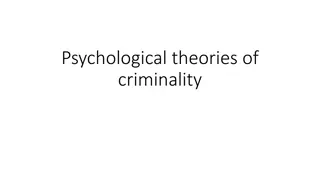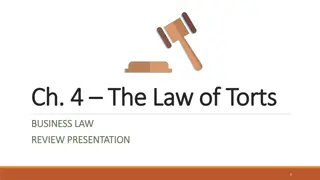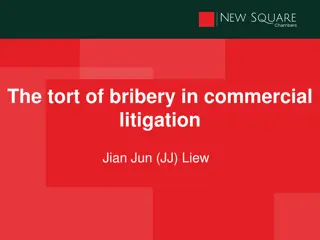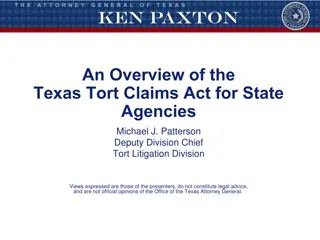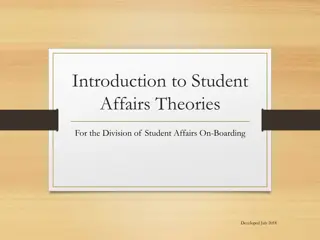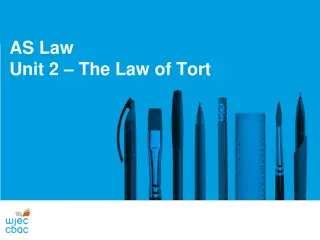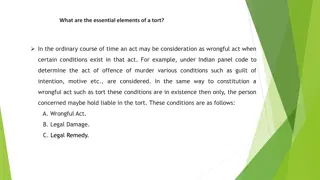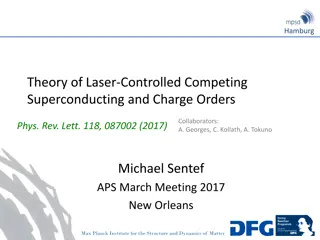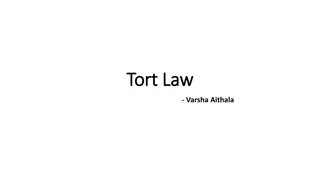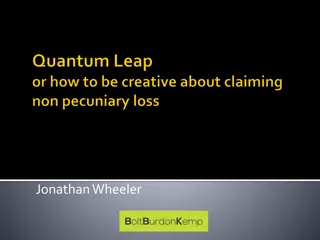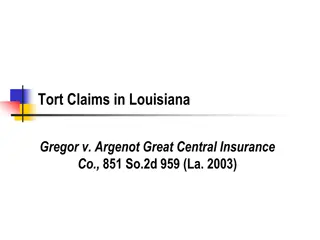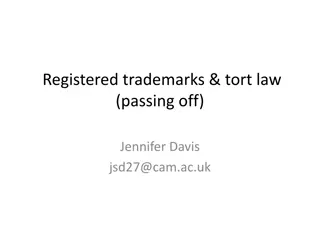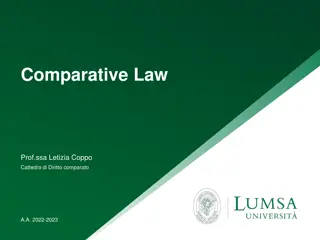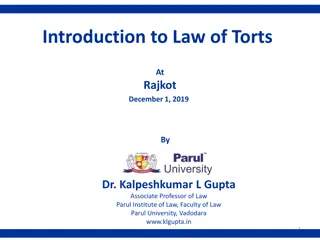Competing Theories on Law of Tort vs Law of Torts
The debate between the theories of Law of Tort and Law of Torts revolves around the principles of liability in legal cases. One theory suggests that all wrongs are actionable as torts, while the other theory limits liability to specific nominate torts. This discussion has influenced the evolution of tort law and the creation of new torts by courts. Wider principles of liability and the concept of absolute liability have been recognized in different legal systems, showcasing the dynamic nature of tort law.
Download Presentation

Please find below an Image/Link to download the presentation.
The content on the website is provided AS IS for your information and personal use only. It may not be sold, licensed, or shared on other websites without obtaining consent from the author.If you encounter any issues during the download, it is possible that the publisher has removed the file from their server.
You are allowed to download the files provided on this website for personal or commercial use, subject to the condition that they are used lawfully. All files are the property of their respective owners.
The content on the website is provided AS IS for your information and personal use only. It may not be sold, licensed, or shared on other websites without obtaining consent from the author.
E N D
Presentation Transcript
Is It Law of Tort or Law of Torts: Question is generally asked in the form, is there a law of tort or only a law of torts? There are two competing theories in this regard. According to one theory, there is a general principle that all wrongs are actionable as tort unless there is any legal justification. The other theory says that there is no general principle of liability as such but only a definite number of torts as trespass, negligence, nuisance, defamation etc. and the plaintiff has no remedy unless he brings his case under one of the nominate torts
It Is Law Of Tort: Winfield is the chief supporter of this theory. He says, all injuries done to another person are torts, unless there is some justification recognized by law. Thus according to this theory tort consists not merely of those torts which have acquired specific names but also included the wider principle that all unjustifiable harm is tortuous. This enables the courts to create new torts. Winfield while supporting this theory comes to the conclusion that law of tort is growing and from time to time courts have created new torts.
This theory is also supported by the creation of new torts by courts of law. For example:- - The tort of inducement to a wife to leave her husband in Winsmore v. Greenbank (1745) Willes 577 (581). - Tort of deceit in its present form had its origin in Pasley v. Freeman (1789) 3 TR 51 - Tort of inducement of breach of contract had its origin in Lumley v. Gye (1853) 2 E & B 216. -The tort of strict liability had its origin in Rylands v. Fletcher (1868) LR 3 HL 330. -The tort of intimidation in Rookes v. Barnard (1964) 1 All ER 367
Indian judiciary has also shown a favour to Winfields theory. In the words of Justice BHAGWATI, C.J., we have to evolve new principles and lay down new norms which will adequately deal with new problems which arise in a highly industrialized economy. We cannot allow our judicial thinking to be constricted by reference to the law as it prevails in England . we are certainly prepared to receive light from whatever source it comes but we have to build our own Jurisprudence. In the same case the Supreme Court of India established the concept of ABSOLUTE LIABILITY in place of strict liability [Ref. case- M.C. Mehta v. Union of India, AIR 1987 SC 1086].
It Is Law Of Torts: Salmond on the other hand, preferred the second alternative and for him, there is no law of tort, but there is law of torts. According to him the liability under this branch of law arises only when the wrong is covered by any one or other nominate torts. There is no general principle of liability and if the plaintiff can place his wrong in any of the pigeon-holes, each containing a labelled tort, he will succeed. This theory is also known as Pigeon-hole theory . If there is no pigeon-hole in which the plaintiff s case could fit in, the defendant has committed no tort. According to Salmond, just as the criminal law consists of a body of rules establishing specific offences, so the law of torts consists of a body of rules establishing specific injuries.
Conclusion: Winfield made a modification in his stand regarding his own theory. He thought that both his and Salmond s theories were correct, the first theory from a broader point of view and the other from a narrower point of view. In the words of Winfield, from a narrow and practical point of view, the second theory will suffice, but from a broader outlook, the first is It is thus a question of approach and looking at the things from a certain angle. each theory is correct from its own point of view.
